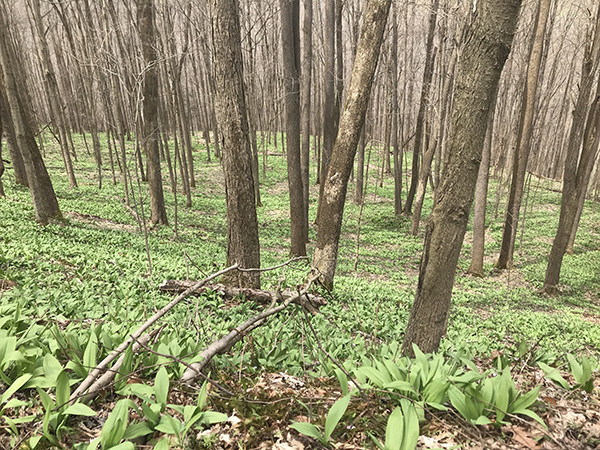As winter begins to loosen its grip and spring begins to peak through the clouds, you may notice more than flowers poking through the forest floor. Morels are the most well-known goal of spring foraging, but ramps and fiddlehead ferns offer a wonderful and sometimes new foraging opportunity for people to try out.
Morels
The most elusive and prized of Ohio’s foraging opportunities would be the Morel. With their earthy, nutty and woodsy flavor, morels are sought after by home cooks and chefs alike. Depending on where you are in the state, the growing season is mid-April through May.
Though seemingly never in the same place twice, the best opportunities for finding morels tend to be near aspen, elms, apple, ash and tulip poplar trees. While you are on the hunt, look for dead or dying trees; morels tend to grow around the base. Temperature also plays a role. Typically, after some rain and a week straight of 50-degree nights, the morels should make their way to the surface. When harvesting morels, pinch or cut the stem just above the soil and store in a mesh bag.
Before you cook the morels, make sure to thoroughly clean them. Shaking them in a paper bag will get some of the dry dirt off but letting them soak in salt water ensures a better clean. My personal favorite way to eat morels is to sauté in some butter and garlic and serve them over a grilled ribeye.
Ramps
A celebrated sign of spring, ramps can be found in sometimes extensive patches covering the forest floor. With a garlic and onion flavor, they are perfect in almost any cooking application. Ramps can be found from late March to May. Known as an understory plant, you will most likely find them under hardwood trees such as beech, maple, birch, tulip poplar, buckeye, hickory and oak.
Ramps are notoriously slow growers, taking five to seven years to reach a harvestable size. As they have grown in popularity, their numbers have taken a downward trend. When harvesting ramps, try to leave the bulb and roots intact so they can be enjoyed for years to come. The way I prefer to eat ramps is to simply cook them with a bit of shrimp, lemon juice, butter and toss with pasta using the ramps instead of garlic.
Fiddlehead ferns
Not as wildly known or sought after is the fiddlehead fern, the tender unfurled fronds of the ostrich fern. Known for tasting like a cross between sweeter asparagus, green beans with an earthy mushroom undertone, in my belief it is widely underutilized. Fiddleheads can be found from April to May.
Fiddleheads can typically be found in areas near water with rich soil and a decent amount of shade. The best place to search for fiddlehead ferns is hardwood forests near a stream or creek. When harvesting fiddleheads, make sure the fern is tightly coiled. The ferns will have a brown papery covering on it that should be removed before consuming.
They should not be eaten raw. The best way I have found to prepare them is to blanch them in salted boiling water and dipping them in a rich sauce such as hollandaise.
Risks
Whether you are a novice forager, or an expert always be sure of what you are consuming. Each of these plants has a poisonous look alike. If you are not 100% sure of what you are consuming, do not consume it. It is also a good idea to check if foraging is allowed in an area before you go. Some state forests allow foraging, but others do not. I hope with some of these tips you can try something new and get outdoors. Happy foraging to all!
(Caitlin Harris is the forestry and wildlife technician for Harrison Soil and Water Conservation District. She can be reached at 740-942-8837 or charris@harrisoncountyohio.org.)
Related Content
- How to enjoy ramp season without overharvesting
- How to tell morel mushrooms and false morels apart
- Morel mushroom hunting tips
- It’s time for hunting ramps and morels


















